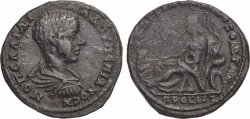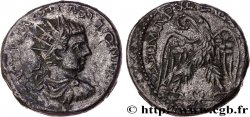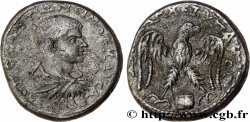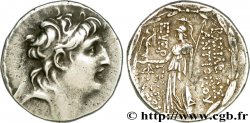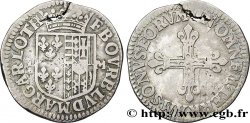v16_0584 - DIADUMENIANO Tétradrachme syro-phénicien
MONNAIES 16 (2002)
Prezzo di inizio : 400.00 €
Valutazione : 700.00 €
lotto invenduto
Prezzo di inizio : 400.00 €
Valutazione : 700.00 €
lotto invenduto
Tipo : Tétradrachme syro-phénicien
Data: 217-218
Nome della officina / città: Arados, Phénicie
Metallo : billone
Diametro : 26 mm
Asse di coniazione : 1 h.
Peso : 12,85 g.
Grado di rarità : R3
Commenti sullo stato di conservazione:
Pas d’usure mais métal poreux et légèrement corrodé, légèrement décentré au revers, faiblesse de frappe sur fin de la légende du droit
N° nelle opere di riferimento :
Pedigree :
Cet exemplaire est le 1254_001 de la base TSP
Diritto
Descrittivo diritto : Buste radié, drapé et cuirassé de Diaduménien à droite, vu de trois quarts en arrière (A2).
Legenda diritto : AU KAI MAR OPEL. ANTwNINOS, (Autokrator Kaisaros Markos Opellios Antwoneinos)
Traduzione diritto : (L’empereur césar Marc Opellius Antonin).
Rovescio
Descrittivo rovescio : Aigle debout de face, les ailes déployées, la tête tournée à gauche, tenant une couronne dans son bec ; entre les pattes, protomé de buffle à droite.
Legenda rovescio : DHMARC EX UPATA, (Dhmarcikhs Ex Upatos A)
Traduzione rovescio : (Revêtu de la puissance tribunitienne consul).
Commento
Même coin de droit que l’exemplaire illustré dans le Prieur. Les tétradrachmes de Syrie, de Palestine ou de Mésopotamie furent frappés en grande quantité lors de la venue de Caracalla au début de la campagne parthique, c'est-à-dire à partir de 215. Après son assassinat, les frappes continuèrent pour Macrin et pour Diaduménien. Dans le cas des séries attribuées à Arados, complexes et comportant différents graveurs, la succession entre les frappes de Caracalla et celles de Macrin et Diaduménien n’est pas évidente d’un point de vue stylistique mais s’appuie sur les continuités de symboles. Le protomé de notre exemplaire montre assez nettement (confirmé par l’animal représenté intégralement sur le revers du Prieur 1252) qu’il s’agit d’un buffle avec une bosse sur le cou et non d’un taureau “occidental”.
Same obverse die as the example illustrated in the Prior. Tetradrachms from Syria, Palestine or Mesopotamia were struck in large quantities during the arrival of Caracalla at the beginning of the Parthian campaign, that is to say from 215. After his assassination, the strikes continued for Macrinus and Diadumenianus. In the case of the series attributed to Arados, which are complex and include different engravers, the succession between the strikes of Caracalla and those of Macrinus and Diadumenianus is not obvious from a stylistic point of view but is based on the continuities of symbols. The protome of our example shows quite clearly (confirmed by the animal represented in its entirety on the reverse of the Prior 1252) that it is a buffalo with a hump on its neck and not a “western” bull.
Same obverse die as the example illustrated in the Prior. Tetradrachms from Syria, Palestine or Mesopotamia were struck in large quantities during the arrival of Caracalla at the beginning of the Parthian campaign, that is to say from 215. After his assassination, the strikes continued for Macrinus and Diadumenianus. In the case of the series attributed to Arados, which are complex and include different engravers, the succession between the strikes of Caracalla and those of Macrinus and Diadumenianus is not obvious from a stylistic point of view but is based on the continuities of symbols. The protome of our example shows quite clearly (confirmed by the animal represented in its entirety on the reverse of the Prior 1252) that it is a buffalo with a hump on its neck and not a “western” bull.








 Segnalare un errore
Segnalare un errore Stampate la pagina
Stampate la pagina Condividi mia selezione
Condividi mia selezione Fai una domanda
Fai una domanda Consegnare / vendere
Consegnare / vendere
 Descrittivo
Descrittivo